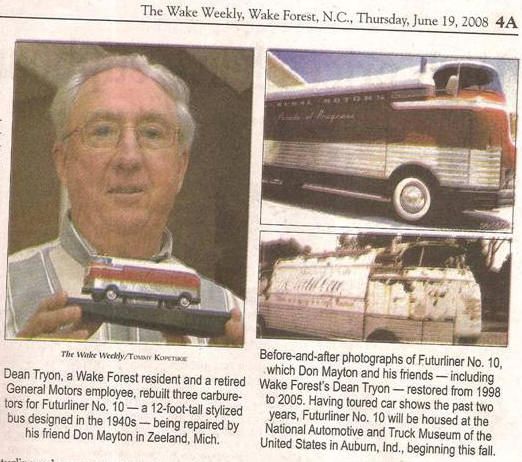|

|
Volunteer Dean Tryon
from Wake Forest, NC was written up in a local newspaper for his
involvement with the Futurliner restoration project. The article
came about after the Futurliner was in Charlotte NC for a big show
in April of 2008. Their PR people contacted the Wake Weekly and they
finally paid him a visit.
Following is an interesting excerpt from that article written
by Tommy Kopetskie.
People Project
Futurliner No. 10 might have been at the center of the work,
but the endeavor was more than a car restoration, Tryon said. And it
wasn’t just car afficionados joining in. “There were guys with a
variety of backgrounds, but most of them had antique car interests,”
said Les Tryon, Dean’s wife. “There were librarians or teachers,
ordinary people who would learn the skill that was needed for that
day’s job.
“It was just a neat group of people.”
Added Dean Tryon, “The project became as much a people
project than it was a restore-this-vehicle project. A camaraderie
developed.”
Beginning in late 1998, volunteers operated outside-in,
restoring the metal body work and engine before moving to the
vehicle’s interior. However, many individual components were done
off-site by volunteers, including Tryon, who rebuilt not one but
three carburetors at home.
“He’d take parts home back to Wake Forest, and work on them
there, and the next time we got together — which was generally in
Hershey, Pa., for a car show — he’d give me the parts, and I would
take them back and install them on the Futurliner,” Mayton
explained.
Tryon actually bolted the carburetor on his 1959 Buick to
make sure the part worked before sending it back to Michigan .
“Since I was down here, and not able to work on it, I did a variety
of small things, like work on carburetors and rebuild the driver’s
seat,” Tryon said. “Those were things I didn’t need to be there to
help with.”
Mayton lauded Tryon for also organizing and distributing the
Futurliner’s twice-a-year newsletter, which is mailed to more than
700 people. “The newsletter brought in a lot of folks that are not
on the internet,” Mayton said. “We discovered a list of the original
people that worked on the Futurliner, mailed them, and once we got
them on the newsletter list, we started getting old photographs,
memorabilia and all types of things.”
But the restoration wasn’t without its mishaps — sometimes
comical — including the Futurliner’s maiden voyage, when one of the
front dual-wheels rolled harmlessly into a nearby ditch.
The “wheel on the loose” was caught on tape, and included on
the vehicle’s documentary “Miracle at Beaverdam: the Restoration of
Futurliner No. 10.”
Nearly seven years after the restoration started, Futurliner
No. 10 was revived to its original form, including its
145-horsepower, 302-cubic-inch GMC gasoline engine, which was
unquestionably too weak for its original size and weight, Tryon
quipped. |
|